If you've ever ventured into the world of plumbing or tried to decipher the jargon on plumbing fixtures, you might have come across the term "FIP." But what does FIP mean in plumbing, and why is it significant? In this article, we'll demystify this acronym, explain its importance in plumbing, and shed light on its various applications.
Understanding FIP: Female Iron Pipe
FIP stands for "Female Iron Pipe," and it's a crucial component in plumbing connections. It's important to understand the role of FIP, especially when you're working on plumbing projects or making repairs.
Female Threads
The "F" in FIP indicates that it's a female-threaded fitting. In plumbing, threads are the grooves that allow pipes and fittings to screw together securely. A female-threaded fitting has threads on the inside, designed to receive and connect with a male-threaded component.
Iron Pipe Size (IPS)
The "IP" in FIP originally referred to "Iron Pipe," which was a common material for plumbing pipes and fittings. However, modern plumbing systems use various materials, including copper, PVC, and PEX. Despite the shift in materials, the terminology has endured, and FIP fittings are still widely used.
Common Uses of FIP in Plumbing
FIP fittings have several essential applications in plumbing systems:
1. Connecting Pipes
- FIP fittings are often used to connect two sections of pipe with male threads. This connection ensures a tight seal, preventing leaks in the plumbing system.
2. Valves and Fixtures
- Many plumbing fixtures, such as faucets and showerheads, have male-threaded connections. FIP fittings are used to attach these fixtures securely to the plumbing pipes.
3. Adapting Pipe Materials
- In situations where different pipe materials need to be connected, FIP fittings can serve as adapters. For instance, if you're transitioning from copper to PVC pipes, an FIP fitting can make the connection possible.
4. Pressure Relief Valves
- Pressure relief valves, a critical safety feature in plumbing systems, often use FIP connections. These valves release excess pressure to prevent pipe damage or explosions.
5. Water Heater Connections
- FIP fittings are commonly used to connect water heaters to the plumbing system. They ensure a secure and leak-free connection between the water heater and the pipes.
Tips for Working with FIP Fittings
When working with FIP fittings in plumbing projects, keep these tips in mind:
- Proper Thread Sealant: Use thread sealant tape or thread sealant compound to ensure a watertight connection.
- Hand Tightening: Hand-tighten FIP fittings and use a wrench for the final snug fit. Exercise caution to prevent over-tightening, as it can harm the threads.
- Compatibility: Ensure that FIP fittings match the size and material of the pipes and fixtures you are connecting.
- Teflon Tape: Applying Teflon tape to the male threads before attaching FIP fittings can help create a better seal and prevent leaks.
In Conclusion
Understanding what FIP means in plumbing is essential for anyone involved in plumbing projects or repairs. FIP fittings play a crucial role in creating secure and leak-free connections in plumbing systems. Whether you're connecting pipes, attaching fixtures, or adapting between different materials, FIP fittings are a valuable component in the world of plumbing, ensuring the integrity and functionality of your plumbing system.

